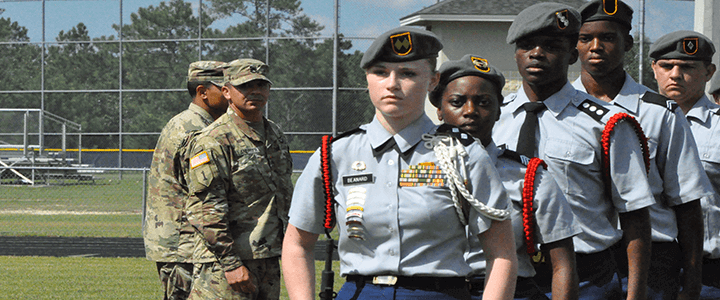Chances are, before this week, many Americans had never heard of JROTC, the Junior Reserve Officers Training Corps program for high school students. I only say this because only a little more than 1,700 of the nation’s 23,000 high schools offer the Army JROTC program, and roughly 1,750 more offer Navy, Marine Corps, Air Force, or Coast Guard JROTC. For those like me who do math on their iPhones, that means only 15 percent of American high schools offer their students a curriculum that stresses leadership and citizenship as much as it stresses math and language arts .
Far from being a military indoctrination program, JROTC is a way for good kids to stay out of trouble and become better citizens. It’s more akin to the Boy Scouts than it is to Basic Training. Sure, the instructors are all retired soldiers. And sure, JROTC cadets wear uniforms to school some days, learn basic drill and ceremonies, and they might even participate in air rifle competitions.
But the bulk of their time in the JROTC classroom is spent reinforcing what they learn in their other classes, and making them better citizens. Judging by the actions of three extraordinary young people in the Marjory Stoneman Douglas High School in Parkland Fla., northwest of Fort Lauderdale, the program is doing an outstanding job.
young candidates stepped into the breach
A school shooting isn’t really germane to national security, so I’ve avoided saying anything about the incident here. Everyone feels strongly about how to react, or not to react, and I’m not stepping into that discussion in this space. But the stories of Alaina Petty, Peter Wang and Martin Duque cannot be told enough.
Anyone who tells you they know exactly how they’d react when real bullets start flying is lying to you. In combat, it’s not uncommon for the biggest, burliest soldier to be reduced to a blubbering mess, or for the “98-pound weakling” to step-up and save the day. There’s simply no way to predict how anyone will react.
But these three young cadets stepped into the breach.
Alaina Petty was only 14 years old, enjoyed participating in color guard, and volunteered at her church.
Like so many other children in south Florida, 14-year-old Martin Duque was an immigrant, moving to Parkland from Mexico.
And Peter Wang, 15, who dreamed of attending the U.S. Military Academy, died holding the door so other students could escape from the killer.
Medal for Heroism
As few Americans who really know anything about JROTC, even fewer know that the Army’s ROTC program, which commissions about 70 percent of the Army’s new second lieutenants each year, has a Medal for Heroism. And JROTC cadets are eligible for it, too. I’m a retired officer who attended college on an ROTC scholarship, and I didn’t know that.
It’s the highest medal available to a cadet. And the Army has awarded it to Petty, Duque, and Wang.
Even more fitting, West Point offered Wang posthumous admission, something the academy says it does “in very rare instances for those candidates or potential candidate’s [sic] whose actions exemplified the tenets of Duty, Honor and Country.” Wang was buried Wednesday in his JROTC uniform with his Medal for Heroism pinned to his chest.
Peter Wang and his two fellow cadets stepped up to the plate. I can only stand here and salute.




